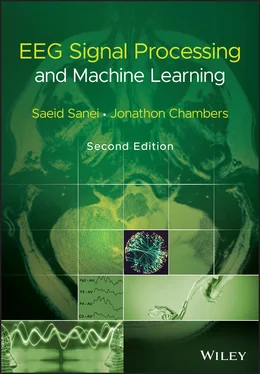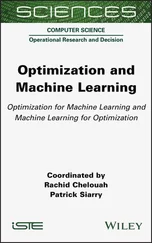Saeid Sanei - EEG Signal Processing and Machine Learning
Здесь есть возможность читать онлайн «Saeid Sanei - EEG Signal Processing and Machine Learning» — ознакомительный отрывок электронной книги совершенно бесплатно, а после прочтения отрывка купить полную версию. В некоторых случаях можно слушать аудио, скачать через торрент в формате fb2 и присутствует краткое содержание. Жанр: unrecognised, на английском языке. Описание произведения, (предисловие) а так же отзывы посетителей доступны на портале библиотеки ЛибКат.
- Название:EEG Signal Processing and Machine Learning
- Автор:
- Жанр:
- Год:неизвестен
- ISBN:нет данных
- Рейтинг книги:3 / 5. Голосов: 1
-
Избранное:Добавить в избранное
- Отзывы:
-
Ваша оценка:
- 60
- 1
- 2
- 3
- 4
- 5
EEG Signal Processing and Machine Learning: краткое содержание, описание и аннотация
Предлагаем к чтению аннотацию, описание, краткое содержание или предисловие (зависит от того, что написал сам автор книги «EEG Signal Processing and Machine Learning»). Если вы не нашли необходимую информацию о книге — напишите в комментариях, мы постараемся отыскать её.
EEG Signal Processing and Machine Learning — читать онлайн ознакомительный отрывок
Ниже представлен текст книги, разбитый по страницам. Система сохранения места последней прочитанной страницы, позволяет с удобством читать онлайн бесплатно книгу «EEG Signal Processing and Machine Learning», без необходимости каждый раз заново искать на чём Вы остановились. Поставьте закладку, и сможете в любой момент перейти на страницу, на которой закончили чтение.
Интервал:
Закладка:
Focal persistent nonrhythmic delta activity (PNRD) may be produced by focal abnormalities. This is one of the most reliable findings of a focal cerebral disturbance. The more persistent, the less reactive, and the more nonrhythmic and polymorphic is such focal slowing, the more reliable an indicator it becomes for the appearance of a focal cerebral disturbance [40–42]. There are other cases such as focal inflammation, trauma, vascular disease, brain tumour, or almost any other cause of focal cortical disturbance, including an asymmetrical onset of CNS degenerative diseases that may result in similar abnormalities in the brain signal patterns.
The scalp EEG amplitude from cerebral cortical generators underlying a skull defect is also likely to increase unless acute or chronic injury has resulted in significant depression of underlying generator activity. The distortions in cerebral activities are because focal abnormalities may alter the interconnections, number, frequency, synchronicity, voltage output, and access orientation of individual neuron generators, as well as the location and amplitude of the source signal itself.
With regards to the three categories of abnormal EEGs, their identification and classification requires a dynamic tool for various neurological conditions and any other available information. A precise characterization of the abnormal patterns leads to a clearer insight into some specific pathophysiologic reactions, such as epilepsy, or specific disease processes, such as subacute sclerosing panencephalitis (SSPE) or Creutzfeldt–Jakob disease (CJD) [37].
Over and above the reasons mentioned above there are many other causes for abnormal EEG patterns. The most common abnormalities are briefly described in the following sections.
2.8 Ageing
The ageing process affects the normal cerebral activity in awake and sleep human, and changes the response of the brain to stimuli. The changes stem from reducing the number of neurons and due to a general change in the brain pathology. This pathology indicates that the frontal and temporal lobes of the brain are more affected than the parietal lobes, resulting in shrinkage of large neurons and increasing the number of small neurons and glia [43]. A diminished cortical volume indicates that there is age related neuronal loss. A general cause for ageing of the brain may be the decrease in cerebral blood flow [43].
A reduction of the alpha frequency is probably the most frequent abnormality in EEG. This often introduces a greater anterior spread to frontal regions in the elderly and reduces the alpha wave blocking response and reactivity. The diminished mental function is somehow related to the degree of bilateral slowing in the theta and delta waves [43].
Although the changes in high‐frequency brain rhythms have not been well established, some researchers have reported an increase in beta wave activity. This change in beta wave activity may be considered as an early indication of intellectual loss [43].
As for the sleep EEG pattern, older adults enter into drowsiness with a more gradual decrease in EEG amplitude. Over the age of 60, the frontocentral waves become slower, the frequency of the temporal rhythms also decreases, and frequency lowering with slow eye movements become more prominent, and spindles appear in the wave pattern after the dropout of the alpha rhythm. The amplitudes of both phasic and tonic NREM sleep EEG [43] reduce with age. There is also significant change in REM sleep organization with age; the REM duration decreases during the night and there is significant increase in the sleep disruption [43].
Dementia is the most frequent mental disorder that occurs predominantly in the elderly. Therefore, the prevalence of dementia increases dramatically with ageing of the society. Generally, EEGs are a valuable diagnostic tool in differentiation between organic brain syndromes (OBSs) and functional psychiatric disorders [43], and together with EPs play an important role in the assessment of normal and pathological ageing. Ageing is expected to change most neurophysiological parameters. However, the variability of these parameters must exceed the normal degree of spontaneous variability to become a diagnostic factor in acute and chronic disease conditions. Automatic analysis of the EEG during sleep and wakefulness may provide a better contrast in the data and enable a robust diagnostic tool. We next describe particular and very common mental disorders whose early onset may be diagnosed with EEG measurements.
2.9 Mental Disorders
2.9.1 Dementia
Dementia is a syndrome that consists of a decline in intellectual and cognitive abilities. This consequently affects the normal social activities, mode, and the relationship and interaction with other people [44]. EEG is often used to study the effect of dementia. In most cases such as in primary degenerative dementia, e.g. Alzheimer's, and psychiatric disorder, e.g. depression with cognitive impairment, the EEG can be used to detect the abnormality [45].
In [45] dementia is classified into cortical and subcortical forms. The most important cortical dementia is Alzheimer's disease (AD), which accounts for approximately 50% of the cases. Other known cortical abnormalities are Pick's disease and CJD. They are characterized clinically by findings such as aphasia, apraxia, and agnosia. CJD can often be diagnosed using EEG signals. Figure 2.13shows a set of EEG signals from a patient with CJD. Conversely, the most common subcortical diseases are Parkinson's disease, Huntington's disease, lacunar state, normal pressure hydrocephalus, and progressive supranuclear palsy. These diseases are characterized by forgetfulness, slowing of thought processes, apathy, and depression. Generally, subcortical dementias introduce less abnormality to the EEG patterns than the cortical ones.
In AD, the EEG posterior rhythm (alpha rhythm) slows down and the delta and theta wave activities increase. Conversely, beta wave activity may decrease. In the severe cases epileptiform discharges and triphasic waves can appear. In such cases, cognitive impairment often results. The spectral power also changes; the power increases in delta and theta bands and decreases in beta and alpha bands and also in mean frequency.
The EEG wave morphology is almost the same for AD and Pick's disease. Pick's disease involves the frontal and temporal lobes. An accurate analysis followed by an efficient classification of the cases may discriminate these two diseases. CJD is a mixed cortical and subcortical dementia. This causes slowing of the delta and theta wave activities and, after approximately three months of the onset of the disease, periodic sharp wave complexes are generated which occur almost every second, together with decrease in the background activity [45]. Parkinson's disease is a subcortical dementia, which causes slowing down of the background activity and an increase of the theta and delta wave activities. Some works have been undertaken using spectral analysis to confirm the above changes [46]. Some other disorders such as depression have lesser effect on the EEGs and more accurate analysis of the EEGs has to be performed to detect the signal abnormalities for these brain disorders.
Generally, EEG is usually used in the diagnosis and evaluation of many cortical and subcortical dementias. Often it can help to differentiate between a degenerative disorder such as AD, and pseudodementia due to psychiatric illness [45]. The EEG may also show whether the process is focal or diffuse (i.e. involves the background delta and theta wave activities). The EEG may also reveal the early CJD‐related abnormalities. However, more advanced signal processing and quantitative techniques may be implemented to achieve robust diagnostic and monitoring performance.
Читать дальшеИнтервал:
Закладка:
Похожие книги на «EEG Signal Processing and Machine Learning»
Представляем Вашему вниманию похожие книги на «EEG Signal Processing and Machine Learning» списком для выбора. Мы отобрали схожую по названию и смыслу литературу в надежде предоставить читателям больше вариантов отыскать новые, интересные, ещё непрочитанные произведения.
Обсуждение, отзывы о книге «EEG Signal Processing and Machine Learning» и просто собственные мнения читателей. Оставьте ваши комментарии, напишите, что Вы думаете о произведении, его смысле или главных героях. Укажите что конкретно понравилось, а что нет, и почему Вы так считаете.












